The Masonry Foundation: A Key To Our Industry's Future
Words: Jeff Buczkiewicz
Words: Jeff Buczkiewicz, MCAA President and CEO
Photos: NCMCA, TMC
The Start
In 2013, the MCAA was faced with a challenge. Other industry partners came to us and asked us to participate in the development of a BIM for Masonry project. It was projected to cost the industry between $1.5 – $2 million, and would require a commitment of $100,000 per year for five years from the partners. If you recall, 2013 was about the time the economy was beginning its rebound from the horrible crash. Markets were finally stabilizing, and the MCAA was beginning to see light at the end of the tunnel.
Our yearly budget was in the very low one-million-dollar range and $100,000 was a serious commitment, as it represented about 10% of our operating budget. Quite frankly, we were not quite sure how we would fulfill the commitment. It was, however, an important issue and the MCAA Board felt compelled to move to approve the commitment. It was left to the Executive Board and Staff to figure out how to fulfill the commitment. That involved the development of our Masonry Foundation. In 2008 we had set up a foundation, but it remained dormant because of the economic conditions.
We had a project that needed funding, and we also needed to raise funds for a corpus (which would live on in perpetuity). We needed to figure out how we would raise money for the Foundation while trying to immediately fund a commitment. Our goal was clear— we did not want mason contractors to be faced with a chance to better the industry but have to pass due to a lack of funds. We had often found that it required a major effort to try to raise funds for that one little opportunity, and then we were left vulnerable again. We were not in control of our destiny. This was an opportunity to take charge of our future, control our destiny, and fund projects we felt would assist our industry and make a better future for everyone. We moved forward with our plan.
The Plan
Fast forward, for the sake of your reading pleasure. We hired a consultant to teach our members and volunteers to explain the importance of these dollars to industry stakeholders. The goal was to build a corpus for the Foundation to support the industry in perpetuity. In layman’s terms, we needed to build a core that would sit in an investment account forever. The industry would help grow the fund, and the only thing we would use would be the investment income.
We rolled up our sleeves, hired our consultant, and began our journey. We started with a training session in Dallas. We had contractors from around the country at the meeting, and they knew we were going to ask them to help us raise money. They did not know that at the end of the meeting, the consultant would tell them that in order to help they needed to buy in themselves. It worked well, and we had commitments before we left. We built on that momentum in the months ahead.
The Early Days
We also set a goal for the Foundation to hit different levels in different phases. Our first phase was to hit $1 million, and our final phase would be to hit $5 million. I have to say, many on the Executive Board were very hesitant to embrace the $5 million mark. Some felt it would be difficult, at best, to hit $1 million. Nonetheless, we moved forward with our two phases. The Executive Board chose not to solicit supplier members and non-members until we reached the halfway mark of $2.5 million. The Executive Board wanted suppliers to know that mason contractors were serious about doing this, and were willing to put their money into it before asking for their support.

A lot of issues had to be ironed out along the way. We had to raise dollars, while also funding the BIM project. We had to make this very clear to the Foundation’s investors. The plan had been to borrow from our corpus and totally pay back the loan before the Board would give out additional funding. That meant any income the investments made was saved and applied to a loan from the corpus. We gained traction and before we knew it, we hit our phase one goal relatively quickly.
Nearing Completion On Phase Two
After about four years, we hit our midpoint of $2.5 million. We then opened up pledges to suppliers. We have seen continued growth, and today I am proud to say the Foundation sits just shy of the $5 million goal, pushing $4.9 million in pledges. It has fully paid back the loan to the corpus through investment returns. The Foundation also began accepting pledge requests and fulfilling them three years ago. All of this has happened with 136 companies and individuals participating in the Foundation. It has been amazing that we have reached nearly $5 million in pledges with only 136 companies participating in this process. This shows there is a tremendous amount of room for continued growth for The Masonry Foundation in the years ahead.

As the money was collected, we formed a Finance Committee that was charged with giving advice to the Board on who to manage the investments and in turn where to put them. The Committee quickly found a savvy investor from one of our member firms— Christian Stein from Arch Masonry. He stepped up to lead the charge to interview and hire an investment firm, and we could not have had a better leader for the committee. Christian did a great job, and personally interviewed and visited with the final three firms. He made a recommendation to hire a firm called DiMeo Schneider (now Fiducient Advisors) out of Chicago. They manage over $100 billion in assets and serve not-for-profits, retirement plans, private individuals and financial institutions. They continue to manage the foundation’s assets and make periodic recommendations to the board to adjust asset allocation.
The First Foundation Grants
As the Foundation Board began the process of opening up to accept grant requests, processes and procedures were developed to make it clear on how the Board would prioritize funding efforts. They also needed to develop a process for allocating funding. They asked Fiducient for advice. Their team stated that the Board should give away between 2-4 % of the corpus every year. Their experience has found that doing so allows the corpus to grow with inflation and stay in real terms where it will last the test of time. That will mean once fully funded at the Phase Two goal of $5 million, the Foundation will be investing between $100,000 and $200,000 per year.
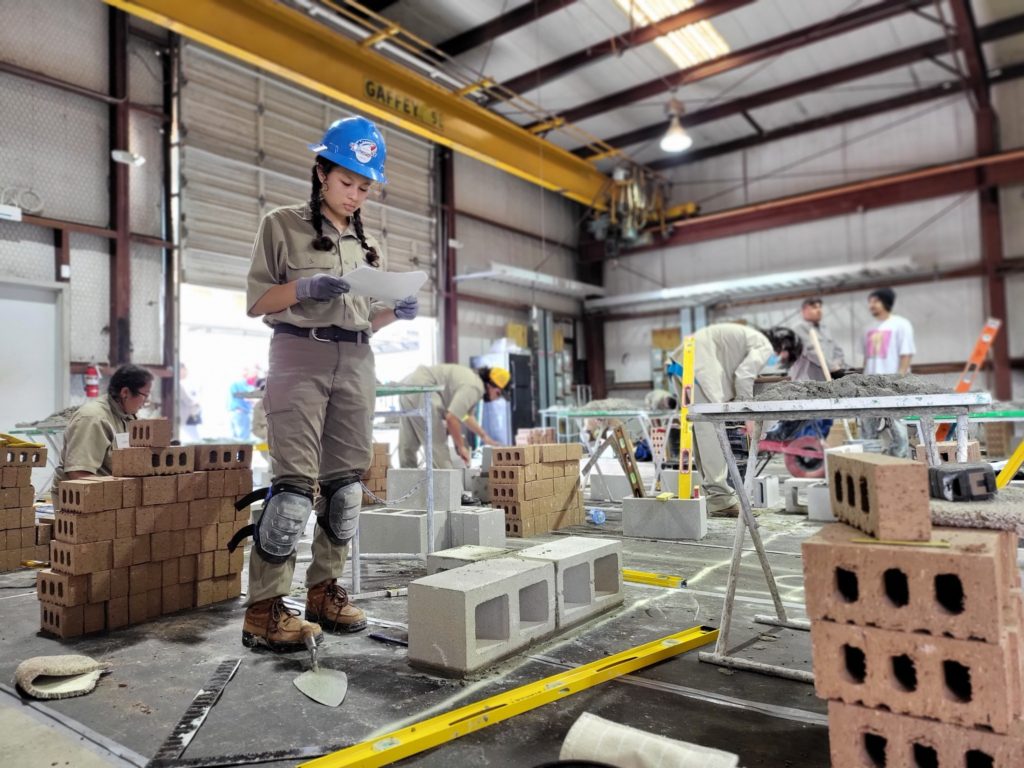
To date, the Foundation has invested over $500,000 in grants to 15 projects. Much of the funding has been used to help workforce development issues, particularly at the high school level and to some degree prison training programs. The Foundation prioritizes national efforts first, then state efforts, then local efforts. As a general rule, the Foundation will not fund initiatives from individual companies, but rather larger industry-focused efforts. Dollars have also been invested in market share initiatives. The Foundation is looking to invest in research initiatives focused on the contractor environment and also looking to help fund efforts to promote masonry to the design community at the university level.
The Future
We are excited about the future for The Masonry Foundation. The development to this point has happened with only 136 industry participants. As we transition to our next phase, the future begins today. We are looking to involve everyone in our industry. There are two programs we see as vital to the continued success of The Masonry Foundation: a planned giving program and expanded industry support.
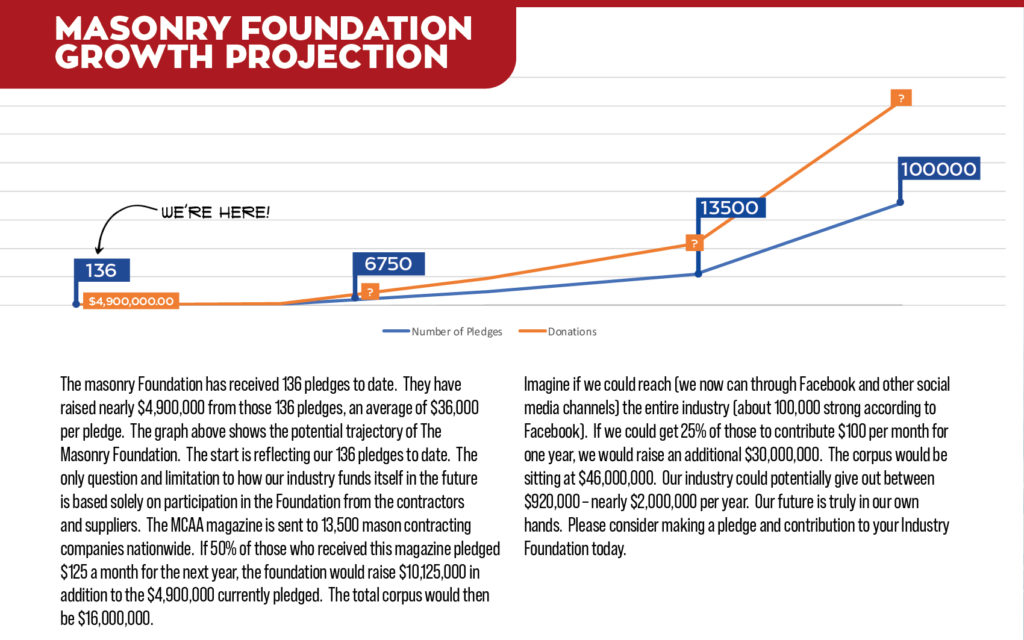
Planned Giving is the process of establishing a designation in a will to support a specific cause. We have several in our industry who have already made this designation in their planning. It is a great way to support the Foundation, and is a pretty simple process. Please feel free to reach out to the MCAA for more details on this. As part of planned giving, some may be interested in designating insurance policies or purchasing one for that purpose. See more on this process in a future issue of MASONRY Magazine. Planned Giving can have tax advantages for your estate as well, and all questions on tax savings should be directed to tax experts handling your estate planning.
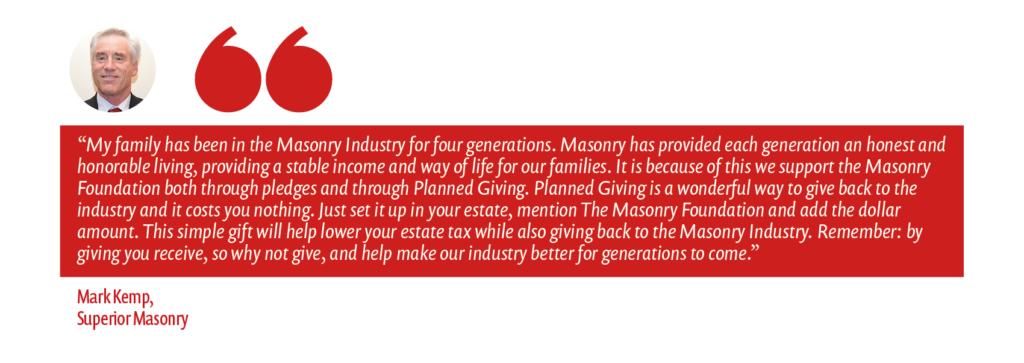
The second way we see The Masonry Foundation growing is through support from the industry as a whole. We are kicking off this process today, and are asking people who read MASONRY to consider supporting your industry’s efforts by making a pledge or contribution today. All donations are tax-deductible charitable contributions. Join the many who have seen the Foundation’s vision as an integral part of bettering our industry. You can make a one-time contribution, or you can make a pledge to the Foundation over time.
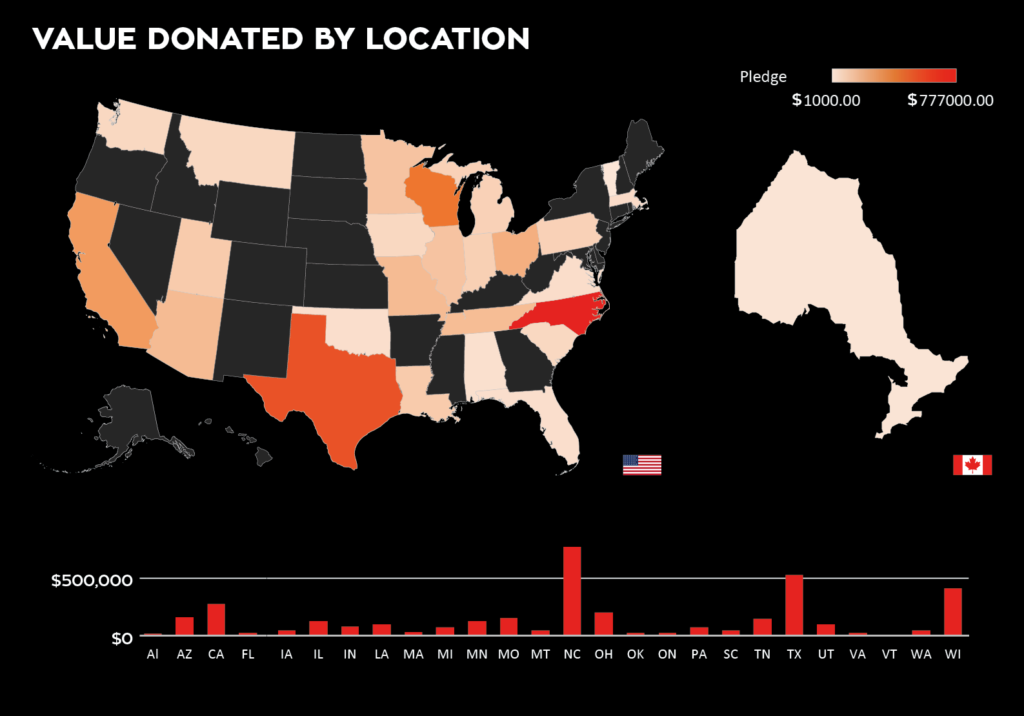
Many who have pledged have a commitment between $25,000 - $100,000+ over time, typically a five-year period. The amount you pledge should be appropriate for your business. We would never want a company to overcommit to the Foundation, and on occasion companies will need to postpone pledge years if they run into a tough year.
The Foundation is intended to support our industry forever, long after this generation of contractors is gone. It is being developed for our industry to take control of our future and have a funding source for contractors to tackle issues they face. If you have questions about the foundation or would like to make a pledge, please feel free to reach out to the MCAA office at 800-536-2225. You can also send an email to Jeff Buczkiewicz (jeffb@masoncontractors.org).
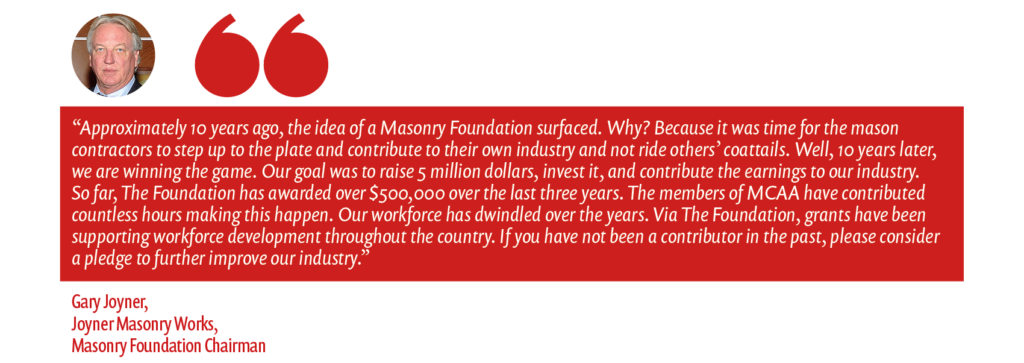
The Masonry Foundation does not have any paid staff. The MCAA’s Staff administer the foundation free of charge in order to keep overhead for the foundation to a minimum. In addition, The Masonry Foundation’s Board is a separate entity from the MCAA’ Board. The Masonry Foundation is a 501(c)(3) charitable foundation, while the MCAA is a 501(c)(6) National Trade Association.